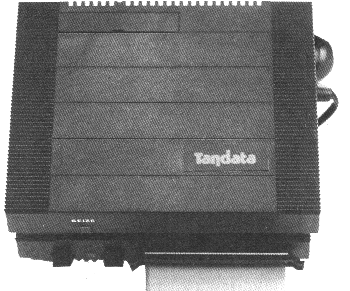Spectre Comms Pack
It's an ill wind that blows nobody good, and the conspicuous lack of QL owners beating a path to Tandata's door to buy the QMod V23 modem has created an entrepreneurial opportunity for Spectre Communications. Take one Qmod, attach a Rom-based Spectre Comms pack for the Spectrum and you've got a neat setup that will operate at 1200/1200/15 and 300/300 (sort of) for under £100. Spectrum owners are of course liable to be a bit perplexed when they unpack the kit and find the packaging's got ''QL'' written all over it, but no matter. The comms package is available separately, but is designed to match the QMod, the complete kit consisting of two black boxes that stack together at the rear of the machine. Plug in the comms pack, fit the QMod onto the expansion bus on top of it, switch on and you're ready to roll. The Rom software cuts in immediately on power up, and presents you with an options menu allowing you to log on or off, go into viewdata terminal mode, save, view or print frames (on a ZX Printer), download software, edit messages and frames or go into scrolling bulletin board mode. The main options menu will either exe-cute the function directly, or will move into a sub-menu presenting other options, log on/off, for example, being split into auto log on, manual log on and log off. If you choose either of the first two you part company with the user friendly menu sys-tem, at this point, as the procedures are the same, and you're simply presented with the query ''Identity?'' Reference to the manual, however, reveals that auto log on is for use with Prestel systems, where identity and password can be entered prior to logging on. This stores the identity and password string in memory, while manual log on is the same, except that doesn't This is one instance where the menus, although nearly user-friendly enough for you to be able to do without a manual, fall down. There's also a problem here with the comms pack itself, which has two switches; a line switch and a mode switch, but as neither is labelled, and the manual fails to tell you which is which, it's possible some users will be confused. Even new users should be able to work out with a bit of thought, but a couple of sticky labels wouldn't go amiss here, and a couple of extra lines in the software indict-ing which switch is which would also be helpful. For the record, the line switch is the one on the right, while the left hand one, the mode switch, takes you between 1200/1200 and 1200/75. The latter is accessed by pushing the mode switch in, and the former by 'out'. Actually getting onto a system is easy, though again it could be a little more obvious. The Spectre doesn't support auto-dial, so with the line switch out you phone the system then push it in when you get a carrier. You're then effectively into the system. The Spectre seemed to log onto Prestel easily enough, and although I initially had trouble with Telecom Gold at 1200/75 and 1200/1200 this seemed to be related to the speed with which the software reacted to a carrier (Gold drops you very quickly if it thinks you're wasting its time) and - possi-bly - to line noise, the local phone system not being all it might be. Storage and printing of frames are among the bells and whistles. Frames can be stored on tape or Microdrive, or can be placed in memory, while although printing is normally on a ZX Printer the manual does tell you which line to modify if you want to use a different printer. In addition to this there's a downloading menu, and offline editing for messages. Bulletin board access is catered for at 1200/75 and 1200/1200, but 300/300 can be produced by a simply wiring job on a cable to Spectre's built-in R5232 port (Sinclair Interface I standard), and by using an external V21 or V23 modem. The scrolling terminal menu controls bulletin board protocols, and can be used to alter word length, parity, stop bits, echo and line feed. From the Spectrum owner's point of view I'd say the Spectre package is decid-edly A Good Thing. It's got a certain amount of flexibility to it in that you aren't tied to owning a dedicated Prestel ma-chine, yet it's simple enough to use for it to be attractive to people new to communica-tions. It would have been nice to have 300/300 built in, and nice to have just a shade more nursemaiding from the software, but overall I'd say it was a good buy. |
| [ Main Page ] [ Features ] |
